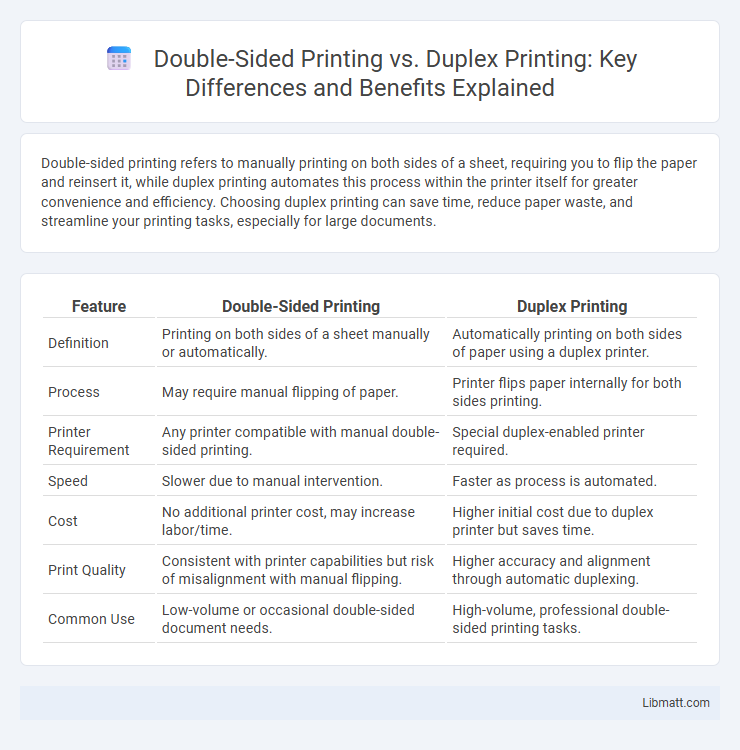Double-sided printing refers to manually printing on both sides of a sheet, requiring you to flip the paper and reinsert it, while duplex printing automates this process within the printer itself for greater convenience and efficiency. Choosing duplex printing can save time, reduce paper waste, and streamline your printing tasks, especially for large documents.
Table of Comparison
| Feature | Double-Sided Printing | Duplex Printing |
|---|---|---|
| Definition | Printing on both sides of a sheet manually or automatically. | Automatically printing on both sides of paper using a duplex printer. |
| Process | May require manual flipping of paper. | Printer flips paper internally for both sides printing. |
| Printer Requirement | Any printer compatible with manual double-sided printing. | Special duplex-enabled printer required. |
| Speed | Slower due to manual intervention. | Faster as process is automated. |
| Cost | No additional printer cost, may increase labor/time. | Higher initial cost due to duplex printer but saves time. |
| Print Quality | Consistent with printer capabilities but risk of misalignment with manual flipping. | Higher accuracy and alignment through automatic duplexing. |
| Common Use | Low-volume or occasional double-sided document needs. | High-volume, professional double-sided printing tasks. |
Introduction to Double-Sided and Duplex Printing
Double-sided printing refers to manually printing on both sides of a paper sheet, requiring the user to flip the pages before printing the reverse side. Duplex printing is an automatic process executed by printers equipped with duplex units, enabling seamless printing on both sides without manual intervention. Understanding the distinction is essential for optimizing document workflows, reducing paper usage, and improving printing efficiency in office environments.
Defining Double-Sided Printing
Double-sided printing refers to the process of printing on both sides of a single sheet of paper manually, often requiring you to flip the paper yourself to print the second side. This method contrasts with duplex printing, where a printer automatically prints on both sides without user intervention. Understanding double-sided printing is essential for managing paper use efficiently and optimizing printing costs in environments lacking duplex-capable devices.
What is Duplex Printing?
Duplex printing refers to the automated process of printing on both sides of a sheet of paper using a printer designed with built-in duplexing capabilities. This technology reduces paper consumption, promotes eco-friendly printing practices, and enhances office productivity by eliminating the need to manually flip pages. Duplex printers use advanced mechanisms to seamlessly print on the front and back sides, distinguishing them from double-sided printing methods that require manual intervention.
Key Differences Between Double-Sided and Duplex Printing
Double-sided printing requires manually flipping the paper to print on both sides, while duplex printing automates this process within the printer. Duplex printing typically involves a dedicated mechanism for automatic two-sided printing, enhancing efficiency and reducing paper jams. The key difference lies in automation, with duplex printing offering convenience and time-saving benefits compared to the manual approach of double-sided printing.
Benefits of Double-Sided Printing
Double-sided printing reduces paper consumption by printing on both sides of a sheet, which lowers operating costs and minimizes environmental impact. It enhances document organization and professionalism, making reports and presentations easier to handle and more visually appealing. This method also increases printer efficiency by cutting down on paper jams and the need for frequent paper replenishment.
Advantages of Duplex Printing
Duplex printing reduces paper consumption by printing on both sides of a sheet automatically, leading to significant cost savings and environmental benefits. It also enhances productivity by minimizing manual intervention and reduces the physical bulk of printed documents for easier storage and distribution. Businesses leveraging duplex printing experience improved workflow efficiency alongside a greener operational footprint.
Manual vs Automatic Double-Sided Printing
Manual double-sided printing requires you to physically flip the pages to print on both sides, which can be time-consuming and prone to misalignment errors. Duplex printing automates this process by using a printer's built-in mechanism to print on both sides of the paper seamlessly, improving efficiency and reducing paper waste. Choosing between these methods depends on your printer's capabilities and your need for speed and convenience in your printing tasks.
Cost Implications of Each Printing Method
Double-sided printing typically involves manually flipping pages, which may increase labor costs and slow down productivity, especially in high-volume print jobs. Duplex printing, performed automatically by duplex printers, reduces paper usage by up to 50%, leading to significant cost savings on paper and ink over time. Your choice between methods impacts overall printing expenses, with duplex printing offering a more cost-efficient solution for businesses aiming to minimize operational costs.
Environmental Impact and Paper Savings
Double-sided printing and duplex printing both significantly reduce paper consumption, leading to substantial environmental benefits by lowering deforestation and waste generation. Duplex printing, which automatically prints on both sides using a printer's built-in mechanism, typically achieves higher efficiency and less paper waste compared to manual double-sided printing. These methods contribute to reducing carbon emissions by decreasing the demand for paper production and minimizing landfill contributions from discarded sheets.
Choosing the Right Printing Method for Your Needs
Double-sided printing refers to manually printing on both sides of a sheet, requiring you to flip the paper, while duplex printing automates this process through a printer with built-in duplex capabilities. Choosing the right method depends on factors such as print volume, speed, and convenience; duplex printers save time and reduce paper waste for frequent, high-volume printing. Your decision should consider cost efficiency and workflow efficiency to optimize printing tasks effectively.
Double-Sided Printing vs Duplex Printing Infographic

 libmatt.com
libmatt.com